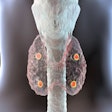
NEW YORK (Reuters Health), Oct 31 - Placental thickness is greater in women with primary cytomegalovirus (CMV) infection than in uninfected pregnant women, particularly in those women who give birth to infants with congenital disease, researchers report. The placental condition responds to hyperimmune globulin treatment, they say.
Dr. Renato La Torre of La Sapienza University in Rome, Italy, and colleagues studied 92 women with primary CMV infection during pregnancy and 73 pregnant women seropositive for CMV but without primary infection.
CMV status was determined at baseline and ultrasound was performed regularly between 16 and 36 weeks' gestation.
The investigators report in the October 15th issue of Clinical Infectious Diseases that placental thickness was greatest in women with CMV infection who gave birth to infants with congenital CMV-related disease such as ventriculomegaly, microcephaly, agyria, thrombocytopenia, or numerous other conditions. Placentas were less thick in women with infection but whose infants did not have congenital disease, and least thick in seropositive women without primary CMV infection.
Placental enlargement appeared to result from "fibrin deposition and small vascularized villi" formed in reaction to hypoxia, Dr. La Torre and colleagues found.
Thirty-two women were treated with hyperimmune globulin to prevent or treat intrauterine CMV infection, and this was associated with "statistically significant reductions in placental thickness," the report indicates.
The team says their observations suggest that "many of the manifestations of fetal and neonatal disease are caused by placental insufficiency."
Editorialist Dr. Mark R. Schleiss of the University of Minnesota in Minneapolis says the findings underline the importance of screening more aggressively for CMV infection, "using serological methods and, when warranted, amniocentesis." Hyperimmune globulin "can be offered to women with highest-risk pregnancies."
Last Updated: 2006-10-27 15:45:14 -0400 (Reuters Health)
Clin Infec Dis 2006;43:994-1003.
Related Reading
US, MR spot life-threatening abdominal pregnancy before it's too late, September 7, 2006
Copyright © 2006 Reuters Limited. All rights reserved. Republication or redistribution of Reuters content, including by framing or similar means, is expressly prohibited without the prior written consent of Reuters. Reuters shall not be liable for any errors or delays in the content, or for any actions taken in reliance thereon. Reuters and the Reuters sphere logo are registered trademarks and trademarks of the Reuters group of companies around the world.

















